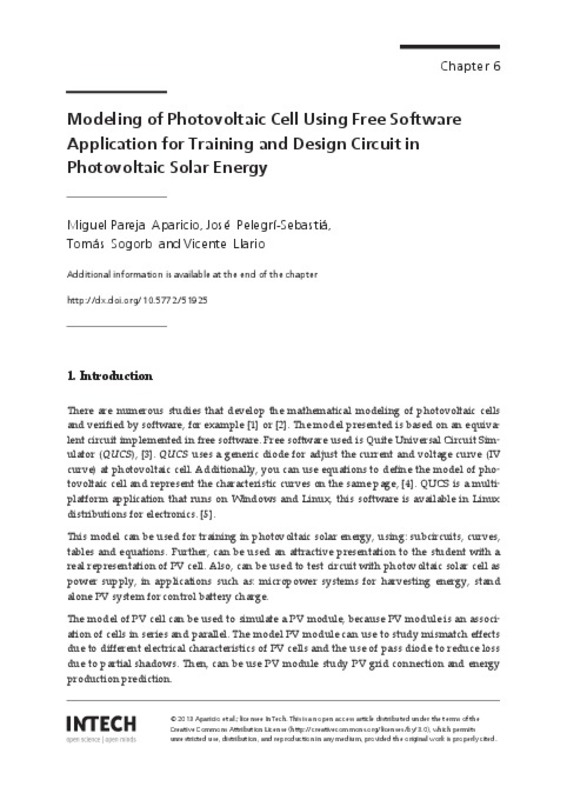JavaScript is disabled for your browser. Some features of this site may not work without it.
Buscar en RiuNet
Listar
Mi cuenta
Estadísticas
Ayuda RiuNet
Admin. UPV
Modeling of Photovoltaic Cell Using Free Software Application for Training and Design Circuit in Photovoltaic Solar Energy
Mostrar el registro sencillo del ítem
Ficheros en el ítem
| dc.contributor.author | Pareja Aparicio, Miguel
|
es_ES |
| dc.contributor.author | Pelegrí Sebastiá, José
|
es_ES |
| dc.contributor.author | Sogorb Devesa, Tomás Carlos
|
es_ES |
| dc.contributor.author | Llario Sanjuan, José Vicente
|
es_ES |
| dc.contributor.editor | Arman, Hasan
|
|
| dc.contributor.editor | Yuksel, Ibrahim
|
|
| dc.date.accessioned | 2014-04-15T07:13:25Z | |
| dc.date.available | 2014-04-15T07:13:25Z | |
| dc.date.issued | 2013 | |
| dc.identifier.isbn | 9789535110408 | |
| dc.identifier.uri | http://hdl.handle.net/10251/37028 | |
| dc.description.abstract | There are numerous studies that develop the mathematical modeling of photovoltaic cells and verified by software. The model presented is based on an equivalent circuit implemented in free software. Free software used is Quite Universal Circuit Simulator (QUCS). QUCS uses a generic diode for adjust the current and voltage curve (IVcurve) at photovoltaic cell. Additionally, you can use equations to define the model of photovoltaic cell and represent the characteristic curves on the same page. QUCS is a multiplatform application that runs on Windows and Linux, this software is available in Linux distributions for electronics. Using QUCS to model a PV cell allows subcircuit and a real representation to a attractive presentation for teaching. In section 5 show examples of practices used on formation, further can be used on: courses of photovoltaic, online formation or distance learning, because only need download QUCS application, and is a good complement to a previous works on labo¿ ratory or concepts review for theory. Advantage to used QUCS is that allow several PV cells with a few mouse click, also does not needs buy additional PV cells to used on laboratory because can be modelled the PV cell available on laboratory. Further, is not a problem the availability material on laboratory, because the material of PV system can be expensive, then is best provide a good photovoltaic devices that a devices for all student in a class. | es_ES |
| dc.language | Inglés | es_ES |
| dc.publisher | InTech | es_ES |
| dc.relation.ispartof | New Developments in Renewable Energy | es_ES |
| dc.rights | Reconocimiento (by) | es_ES |
| dc.subject | PV cells | es_ES |
| dc.subject | Mathematical modeling of photovoltaic cells | es_ES |
| dc.subject | Quite Universal Circuit Simulator | es_ES |
| dc.subject.classification | TECNOLOGIA ELECTRONICA | es_ES |
| dc.title | Modeling of Photovoltaic Cell Using Free Software Application for Training and Design Circuit in Photovoltaic Solar Energy | es_ES |
| dc.type | Capítulo de libro | es_ES |
| dc.identifier.doi | 10.5772/51925 | |
| dc.rights.accessRights | Abierto | es_ES |
| dc.contributor.affiliation | Universitat Politècnica de València. Departamento de Ingeniería Electrónica - Departament d'Enginyeria Electrònica | es_ES |
| dc.contributor.affiliation | Universitat Politècnica de València. Instituto de Investigación para la Gestión Integral de Zonas Costeras - Institut d'Investigació per a la Gestió Integral de Zones Costaneres | es_ES |
| dc.description.bibliographicCitation | Pareja Aparicio, M.; Pelegrí Sebastiá, J.; Sogorb Devesa, TC.; Llario Sanjuan, JV. (2013). Modeling of Photovoltaic Cell Using Free Software Application for Training and Design Circuit in Photovoltaic Solar Energy. En New Developments in Renewable Energy. InTech. 121-139. doi:10.5772/51925 | es_ES |
| dc.description.accrualMethod | S | es_ES |
| dc.relation.publisherversion | http://dx.doi.org/10.5772/51925 | es_ES |
| dc.description.upvformatpinicio | 121 | es_ES |
| dc.description.upvformatpfin | 139 | es_ES |
| dc.relation.senia | 235027 |








